

Easter is here - as I write this week's Journal it is 'Good Friday' - the weather today is far from good, with a light drizzle hanging about all day. At least spending the day indoors writing is not accompanied by a wistful look at sunshine outside.
In previous English Apple Man Journals the subject of root-stocks has been discussed. Last week at the HDC Tree Fruit day, Felicidad Fernandez - Research Leader, Plant Breeder and Molecular Geneticist presented:
Rootstock breeding and trialing at EMR
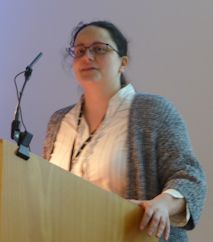 The East Malling Rootstock Club (EMRC) was established in 2008 and aims to deliver improved rootstocks to UK growers, with support from the Horticultural Development Company (HDC), and to overseas producers with funding provided by the International New Varieties Network (INN). EMRC's remit is to breed, develop, distribute and commercialise new and improved rootstock material for apple and pear production, encompassing a diverse range of agronomic variation and resistance to pests and diseases.
The East Malling Rootstock Club (EMRC) was established in 2008 and aims to deliver improved rootstocks to UK growers, with support from the Horticultural Development Company (HDC), and to overseas producers with funding provided by the International New Varieties Network (INN). EMRC's remit is to breed, develop, distribute and commercialise new and improved rootstock material for apple and pear production, encompassing a diverse range of agronomic variation and resistance to pests and diseases.
Breeding a new rootstock is a 'long drawn out affair' and delivering a rootstock capable of improving global fruit production takes between 25 - 35 years.
In 2001, East Malling's most recent rootstock selections were released: for apple M116, and for pear the quince rootstock EMH. The crosses that produced these rootstocks were both made in the 1960's - an indication of just how long a process it is to produce a new improved rootstock.
Partnership with INN and HDC from 2008 - 2020
Major objectives
Search for a range of vigour for different growing conditions - Pest and Disease resistance is vital for a future reduction in the use of Pesticides; this would take into account Scab & Mildew - additionally resistance to WAA (woolly apple aphid), phytophthora and FB (fire blight) - Pear decline is an important challenge for breeders - Yield efficiency anchorage and ease of propagation.
Pear Decline - UC (University of California) IPM
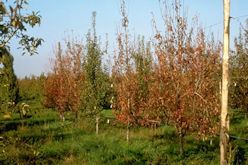 "The phytoplasma organism that causes pear decline is transmitted by pear psylla when feeding on pear foliage. An infected pear tree is the only known host from which uninfected pear psylla can acquire the pear decline phytoplasma. The expression of the disease depends on rootstock susceptibility, tree vigor, and psylla numbers. The organism multiplies in both pear trees and in pear psylla. Good horticultural practices and pear psylla control can help decrease the impact of pear decline when pear trees are grafted onto tolerant rootstocks".
"The phytoplasma organism that causes pear decline is transmitted by pear psylla when feeding on pear foliage. An infected pear tree is the only known host from which uninfected pear psylla can acquire the pear decline phytoplasma. The expression of the disease depends on rootstock susceptibility, tree vigor, and psylla numbers. The organism multiplies in both pear trees and in pear psylla. Good horticultural practices and pear psylla control can help decrease the impact of pear decline when pear trees are grafted onto tolerant rootstocks".
M9 is the most prolific rootstock in the world. From the work carried out at East Malling Research Station in the after its inception in 1913 and subsequent work in the 1920's, identifying different rootstocks vigour, M9 (M stands for Malling) became the favourite for more intensive production, initially using Bush Trees as the management format, before 'centre leader' trees became the standard for tree shape.
M9 - a bit of history
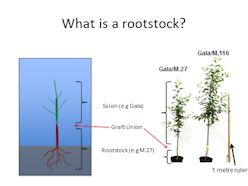 M9 (Type IX Jaune de Metz) a chance seedling found in France in 1879. On a vigour scale of 0-100% - (using MM106 as the 100% barometer) M9 sits at around 25% - 35%. Its moderate vigour promotes precocity. It is still the most widely grown rootstock globally, BUT it is susceptible to many pests and diseases (P&D) and it demonstrates poor anchorage.
M9 (Type IX Jaune de Metz) a chance seedling found in France in 1879. On a vigour scale of 0-100% - (using MM106 as the 100% barometer) M9 sits at around 25% - 35%. Its moderate vigour promotes precocity. It is still the most widely grown rootstock globally, BUT it is susceptible to many pests and diseases (P&D) and it demonstrates poor anchorage.
By comparison to M9 - M26 sits on the scale of vigour at 60% with M116 at 95% and MM106 at 100%.
In 1917 The Malling Research Station joined forces with the John Innes Institute at Merton to breed some aphid-resistant rootstocks: the MM101-115 series.
M denotes a Malling rootstock, MM denotes a Malling-Merton hybrid.series
EMA & C (Quince)
Moderate to good vigour control - good yield efficiencies in high density orchards - poor nutrient uptake at high pH levels
Breeding cycle and objectives
Below: Woolly Apple Aphid damage
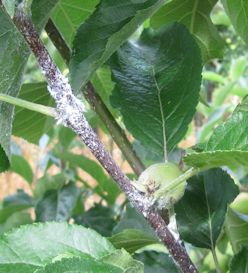 Feli Fernadez outlined the process for breeding a new rootstock suitable for 'global' use; it is important to understand when seeking a new commercial rootstock, it MUST have the ability to meet the soil and climatic conditions in ALLthe commercial growing regions throughout the World!
Feli Fernadez outlined the process for breeding a new rootstock suitable for 'global' use; it is important to understand when seeking a new commercial rootstock, it MUST have the ability to meet the soil and climatic conditions in ALLthe commercial growing regions throughout the World!
Choosing parents - the initial stage requires controlled crossing (year 0) where breeders cross pollinate from promising parents - Raising seedling populations and planting out (year 1) - Bud with a common scion (variety) (year 2) - Evaluate in the field (years 5 - 7) - looking at traits for Vigour - Crop load - Suckering - Anchorage.
Once identified promising rootstocks are multiplied for replicated trials (years 8 - 10) - Factors evaluated are rooting ability - susceptibility to pest & disease, which will include as priority -
Woolly apple aphid - Fireblight - Phytopthora Cactorum - Apple Replant Disease.
Below: Scab on a Bramley apple. Mildew. Brown staining from Fireblight infection
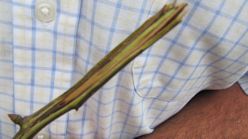
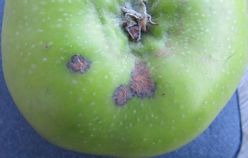

Below: Fireblight damage on a Pear tree
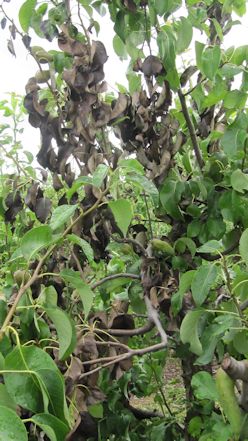 Preliminary trials (years 10 -17)
Preliminary trials (years 10 -17)
Grafting or budding with a common scion - 'example Gala' - Size: girth and tree volume - Yield efficiency and fruit size are important characteristics - Bulking up material (years 15 - 20) - Grafting or Budding onto a range of scions (varieties) come next.
Multisite trials (years 18 - 26/30)
Grafting or Budding onto a range of scions; example - Gala, Braeburn, et al and trialed on a range of different sites.
Virus indexing and establishment of mother trees (year 20 - on-wards)
IP (International Property) protection and commercial release (years 25 - 35) and a 'new' rootstock MAY be ready to change the world of commercial Apple (or Pear) production.
It all started with breeders selecting parent rootstocks considered to have promising attributes; e.g. resistance to pest and disease and by crossing parents with positive attributes, hope to find 'offspring' capable of producing a new commercial rootstock combining the positive attributes of their parents.
In the early stage; 6,000 apple and 2,500 pear seedlings were trialed between 2008 - 2015 as part of TF182: EMRC - INN - HDC Breeding Programme.
In existing HDC trials - CE190: two apple rootstocks (2004 - 2014): neither outstanding in UK - both are susceptible to fire blight and WAA (woolly apple aphid) while another five selections; 2 conventional with 2 scions under EE207 (2010 - 2020?) have found none outstanding to date. VF224: 4 selections, organic and one scion (2010 - 2020?) - status to date; R80 so far the most productive -AR809-3 the most dwarfing of the group - P&D testing ongoing.
TF224 - EMRC: INN and HDC breeding and trialing - phasing in marker assisted breeding - main changes to trials - use of DNA verification of TTT of trial material - recorded pruning on trials - bigger emphasis on characterisation - P&D resistance - nursery properties.
Around the World, there is a wide mix of climatic conditions; hot, cold, wet, dry, and to be globally successful a new rootstock must be adaptable to all climates and capable of bonding with all the mainstream varieties. INN trial; material is starting to move outside EU for evaluation in other climatic conditions.
Finally; The English Apple Man highlights the importance of rootstock breeding at East Malling - it all started 112 years ago and the work of breeders there has spread to every corner of Global Top Fruit Production.
Below: an extract from EMR website:
The Malling (M) series and Malling/Merton (MM) series (with John Innes Inst.) of rootstocks are used in virtually every part of the world where apples are grown commercially and it is estimated that 90% of apple orchards in Western Europe are grafted onto M9.
Apple rootstocks M1-M16 were released between 1912-1914, and M17-M24 in 1924.
In the 1920's the quince rootstocks QA and QC were released and became very widely used for pears as did Myrobalan Brompton and St. Julian A for plum.
In the 1950's the MM series of apple rootstocks, selected for their resistance to woolly apple aphid, as well as M25 (1952) and the semi-dwarfing M26 (1959) were released.
More recent releases include the dwarfing apple rootstock M27 (1975), the plum rootstock Pixy (1977) and cherry rootstocks Colt (1977), Cob (1980) and Charger (1986).
That is all for this week.........
Take care
The English Apple Man